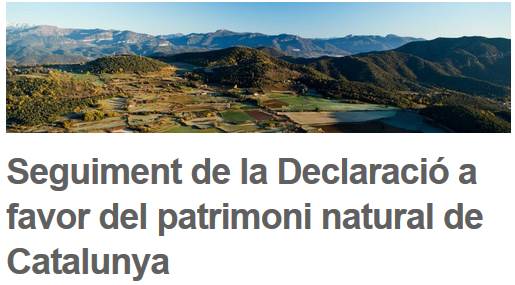| Poblacions marginals: valor en conservació |
 |
 |
 |
| divendres, 11 de febrer de 2011 12:56 | |||
|
Poblacions marginals: valor en conservació Cèsar Blanché Les poblacions de plantes a l’extrem/perifèria de llur àrea de distribució han rebut diversa atenció per la seva vulnerabilitat o per la seva diferenciació genètica més o menys marcada. Tres articles recents sobre espècies de la nostra flora (Cypripedium calceolus, Cyclamen balearicum o Dichoropetalum schottii) aporten noves dades per a interpretar correctament aquestes poblacions extremes.
D’una banda, Garcia et al (2010), tot partint de la consideració establerta que les poblacions marginals de l’àrea de distribució de les espècies són més vulnerables que les poblacions centrals, es fan ressò de revisions recents que posen en dubte aquesta generalització. Tot examinant el rendiment reproductiu i demogràfic de poblacions pirinenques de Cypripedium calceolus, orquídia-insignía de la conservació de flora a Europa, conclouen que, contràriament a les expectatives, les poblacions estudiades (marginals) tenen millors resultats d’èxit reproductiu i de taxes de creixement que no pas les poblacions de l’àrea central i ho relacionen amb la reforestació dels darrers 50 anys a les muntanyes del sud d’Europa. L’equip del BioC, ha analitzat els nivells de diversitat i l’estructura genètica de la població ibèrica extrema (SW) de Dichoropetalum schottii en el conjunt de l’àrea de distribució (Blanché et al, en premsa). Els resultats (nivells més baixos de diversitat isoenzimàtica) són congruents amb la petita mida poblacional i amb la situació marginal excèntrica respecte a l’àrea de distribució total. Tanmateix, el nucli pirinenc en conjunt (poblacions de la Garrotxa i de l’Arièja) pot ser distingit com una fracció significativa de la variació genètica de l’espècie, caracteritzada per la presència d’al·lels privats i per un origen relativament recent, a partir d’una estirp procedent de les muntanyes mediterrànies orientals. El conjunt de poblacions pirinenques és identificable com a unitat funcional de conservació, per a la qual es proposen mesures de conservació. En conjunt, doncs, les dades recents segueixen apuntant a l’interès que tenen les poblacions extremes i marginals (ni que es presentin empobrides genèticament o que pateixin fenòmens d’introgressió), la diversitat de fenòmens que hi tenen lloc i la rellevança que siguin considerades com a unitats especials mereixedores de mesures de conservació. I, en especial, mereix ser destacat que aquestes recerques provenen de tàxons de la nostra flora, que comença a fornir dades al coneixement que, fins fa poc, era exclusiu d’altres territoris florístics.
Abstract Dichoropetalum schottii is a taxon of S. European mountains reaching its western distribution limit at the Pyrenees. A single Iberian location is known, hosting c. 250 individuals (CR according to IUCN 2001 categories). It is also known in France from some ten localities in the Eastern Pyrenees and protected by law in Catalonia and Languedoc-Roussillon. Allozyme variation of Pyrenean populations has been studied. Parameters of genetic variation (P99, A, He) for eight loci show lower values for the Catalan population (25.0; 1.37; 0.100, respectively) than for the remaining Pyrenean populations (37.5-50; 1.50; 0.112-0.134), in congruence with small population size and marginal excentric situation in relation with the total distribution area. By comparing the obtained data with those of populations of the whole distribution area, we conclude that the Pyrenean populations set can be distinguished as a significant portion of genetic variation, characterized by private alleles and by a relatively recent origin, coming from an E-Mediterranean mountain stock. The set of Pyrenean populations can be identified as a functional conservation unit for which conservation measures are proposed.
Abstract Fragmentation of animal and plant populations typically leads to genetic erosion and increased probability of extirpation. Although these effects can usually be reversed by reestablishing gene flow between population fragments, managers sometimes fail to do so due to fears of outbreeding depression (OD). Rapid development of OD is due primarily to adaptive differentiation from selection or fixation of chromosomal variants. Fixed chromosomal variants can be detected empirically. We used an extended form of the breeders’ equation to predict the probability of OD due to adaptive differentiation between recently isolated population fragments as a function of intensity of selection, genetic diversity, effective population sizes, and generations of isolation. Empirical data indicated that populations in similar environments had not developed OD even after thousands of generations of isolation. To predict the probability of OD, we developed a decision tree that was based on the 4 variables from the breeders’ equation, taxonomic status, and gene flow within the last 500 years. The predicted probability of OD in crosses between 2 populations is elevated when the populations have at least one of the following characteristics: are distinct species, have fixed chromosomal differences, exchanged no genes in the last 500 years, or inhabit different environments. Conversely, the predicted probability of OD in crosses between 2 populations of the same species is low for populations with the same karyotype, isolated for <500 years, and that occupy similar environments. In the former case, we recommend crossing be avoided or tried on a limited, experimental basis. In the latter case, crossing can be carried out with low probability of OD. We used crosses with known results to test the decision tree and found that it correctly identified cases where OD occurred. Current concerns about OD in recently fragmented populations are almost certainly excessive.
Abstract
Abstract
pdf/handle/citació
|
|||
| Darrera actualització de dilluns, 24 d'octubre de 2011 13:41 |

















